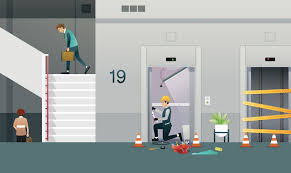Commercial elevators are the unsung heroes of modern business operations, keeping employees, customers, and goods moving smoothly through multi-story buildings. They’re essential in offices, malls, hospitals, hotels, and other high-traffic areas where reliability is key. But just like any other mechanical system, elevators need regular maintenance to ensure safety, minimize downtime, and extend their lifespan.
If you’re responsible for managing a building with commercial elevators, knowing how to maintain them properly is crucial. In this guide, we’ll cover essential tips for keeping your elevators in top-notch condition while avoiding common pitfalls like unexpected malfunctions and costly repairs.
1. Understand the Importance of Regular Inspections
Elevators are complex systems with thousands of moving parts. Regular inspections by certified technicians are vital for identifying wear and tear, preventing potential failures, and ensuring compliance with safety standards. Most local regulations mandate routine inspections, but going beyond the bare minimum can save you significant headaches down the road.
Schedule maintenance checks at least quarterly, and partner with a trusted company like Elevator One, known for its top-notch service and TSSA ratings. Regular inspections will help you avoid costly Elevator Maintenance issues, ensuring a safer and smoother ride for everyone.
2. Keep a Maintenance Log
A maintenance log is an essential tool for tracking your elevator’s performance and maintenance history. This log should document all inspections, repairs, and any unusual performance issues reported by users.
Why is this important? A detailed log helps technicians identify recurring problems, allowing them to address root causes more effectively. It’s also helpful for staying on top of warranty requirements and legal obligations.
3. Invest in Preventive Maintenance
Preventive maintenance is your best defense against unexpected breakdowns. It goes beyond regular inspections and involves proactive measures such as:
- Lubricating moving parts.
- Replacing worn-out components before they fail.
- Testing emergency systems, including brakes, alarms, and communication devices.
- Cleaning the elevator shaft to remove debris that could interfere with its operation.
Preventive maintenance might feel like an added expense, but it’s far cheaper than dealing with downtime, repairs, or liability issues from accidents. Companies like Elevator One specialize in designing preventive maintenance plans tailored to your elevator system’s unique needs.
4. Respond Promptly to Warning Signs
Elevators rarely fail without warning. Pay attention to signs like unusual noises, jerky movements, or doors that don’t open or close properly. These issues might seem minor, but they can indicate more significant problems brewing beneath the surface.
Encourage building occupants to report issues immediately, and don’t delay calling a technician for an evaluation. Ignoring warning signs can lead to costly Commercial Repairs and potentially jeopardize the safety of your passengers.
5. Educate Your Building Staff and Occupants
Elevator performance isn’t just about technical maintenance—it’s also influenced by how people use it. Educating building occupants and staff about proper elevator usage can go a long way in preventing unnecessary wear and tear.
Share tips such as:
- Avoid overloading the elevator beyond its weight capacity.
- Don’t hold doors open forcefully; use the “door open” button instead.
- Report any spills, debris, or damage inside the elevator immediately.
Clear signage can also be helpful in guiding users on proper elevator etiquette.
6. Monitor Elevator Performance Remotely
Modern commercial elevators often come equipped with advanced monitoring systems that allow building managers to track performance in real-time. These systems can detect issues like speed irregularities, door malfunctions, or temperature fluctuations within the motor room.
Remote monitoring is particularly useful in busy commercial environments, where downtime can disrupt operations. By catching potential problems early, you can schedule repairs proactively and avoid elevator downtime, keeping your business running smoothly.
7. Work With a Reliable Maintenance Provider
Choosing the right elevator maintenance provider can make or break your maintenance strategy. Look for a company with a proven track record, excellent customer reviews, and certified technicians.
Elevator One, for example, is a trusted name in the industry, offering maintenance, repair, and modernization services backed by stellar Google reviews and Ontario’s highest TSSA ratings. They understand the unique demands of commercial elevators and can help you craft a maintenance plan that fits your building’s needs.
8. Don’t Neglect Safety Systems
Commercial elevators are equipped with multiple safety systems, including emergency brakes, alarms, and backup power. These features must be tested regularly to ensure they function correctly in emergencies.
In addition to professional inspections, you can perform simple safety checks, such as:
- Testing the emergency phone or communication system.
- Ensuring fire service mode operates as intended.
- Confirming the proper operation of stop switches.
9. Budget for Major Repairs and Modernization
No matter how diligent your maintenance efforts are, your elevator will eventually require major repairs or upgrades. Budgeting for these expenses ahead of time ensures you’re prepared when the need arises.
Modernization, in particular, can be a worthwhile investment for older elevators. Upgrading control systems, motors, and doors can improve energy efficiency, performance, and passenger experience. Discuss modernization options with your maintenance provider to determine what’s best for your building.
10. Stay Compliant With Local Regulations
Commercial elevators are subject to strict safety and performance regulations, which vary by location. Non-compliance can result in fines, lawsuits, or even elevator shutdowns.
Work closely with your maintenance provider to ensure your elevators meet all local codes and standards. This includes scheduling mandatory inspections, adhering to repair timelines, and keeping detailed records of maintenance activities.
11. Prepare for Emergencies
Even with the best maintenance plan, emergencies can happen. Preparing your building for elevator-related emergencies is essential for minimizing risk and ensuring passenger safety.
Create an emergency plan that includes:
- Contact information for your maintenance provider and emergency repair services.
- Instructions for evacuating passengers in case of entrapment.
- Regular training for building staff on handling elevator emergencies.
Being prepared can make a significant difference in how quickly and effectively you resolve unexpected issues.
12. Review Your Maintenance Plan Regularly
Your elevator’s needs may change over time due to factors like increased usage or aging components. Reviewing your maintenance plan annually ensures it remains aligned with your elevator’s condition and your building’s requirements.
Schedule a consultation with your maintenance provider to discuss performance trends, upcoming repairs, and potential upgrades. Staying proactive will help you avoid costly surprises and maintain smooth operations.
Partner With Experts for Reliable Service
Maintaining commercial elevators is no small task, but with a proactive approach and the right partners, you can keep your systems running efficiently and safely. Whether you need routine maintenance, modernization, or Commercial Repairs, working with an experienced provider like Elevator One ensures you’re in good hands.
Ready to take your elevator maintenance to the next level? Contact Elevator One today and experience the difference that expert care can make for your commercial property.



































